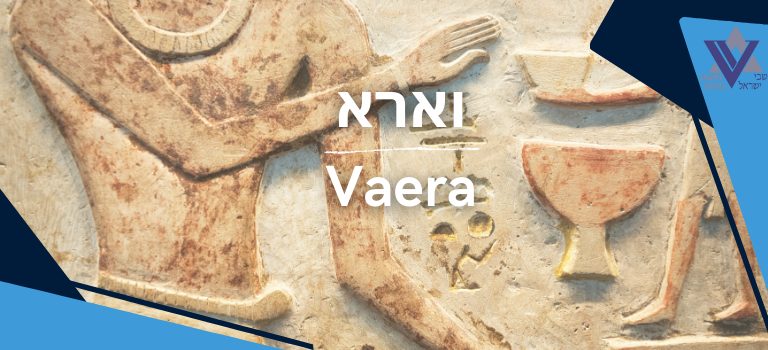
Parashat Vaera
Parshat Vaera is the transition from Divine promises to Divine action. Responding to Paro’s first refusal at the end of last week’s Parsha, G-d assures Moshe that He will release the Jewish people from slavery and bring them to the land of Israel. After Moshe’s reluctance, Moshe and Aharon are sent to Paro. The first seven plagues occur: blood, frogs, lice, wild animals, animal disease, boils, hail. Paro responds in fits and starts, at times acquiescing then changing his mind.
1st Aliya (6:2-13) In response to the futility of Moshe’s approach to Paro at the end of last week’s Parsha G-d responds firmly and definitively: I am G-d, a name unknown to the Avot. I promised to them the land of Israel. I heard the people’s cries. And I remember the covenant. So tell the people: I, G-d, am taking them out, saving them, redeeming them, bringing them to Me, bringing them to the Land. The people cannot hear due to their burdens. G-d tells Moshe to go to Paro. He objects: the people didn’t hear me, how will Paro?
In this aliya, G-d establishes the most fundamental of Jewish beliefs: G-d’s direct intervention in Jewish history. Up until now, we know G-d as the One who Promises to Avraham that he will be given the land of Israel. But we have yet to see this promise become a reality. The promise of the land has not been granted.
Everything changes now. Now, for the first time, instead of man having to search, to peer behind the scenes for the Divine, He tells us exactly what He is going to do. And it happens immediately. He tells Moshe and the people in vivid Technicolor detail exactly what He is going to do: take them out, save them, redeem them, bring them to Him, bring them to the Land.
We will see this even more vividly in the plagues themselves; He will say what He is going to do today or what He will do tomorrow. And then does it immediately. That is why there are 10 plagues. He wants to demonstrate over and over that He is controlling the world and hence also, human history.
2nd Aliya (6:14-29) The lineage of Reuven, Shimon and Levi is outlined. Including the birth of Moshe and Aharon. These are the Aharon and Moshe who G-d commanded to go to Paro. The ones who speak with Paro.
Perhaps Moshe’s lineage is given in order to highlight that he is not a leader by dint of lineage. He is not from the first-born son Reuven. Nor from the first-born son of Levi. Nor even the first-born son of Amram. Moshe is not a leader by dint of lineage.
3rd Aliya (6:30-7:7) G-d tells Moshe to go to Paro. Moshe objects: I am tongue-tied, how will Paro listen? G-d tells Moshe: I am making you Paro’s judge and Aharon your mouthpiece. I will harden Paro’s heart. He will not listen to you.
Here the detail of what will transpire begins. By normal political measures, Moshe knows he will not be successful. He, weak. Paro, powerful. But he is told that he and Paro are but pawns in the Hand of G-d.
4th Aliya (7:8-8:6) The plagues begin. Go to Paro in the morning when he goes to the river. In this you will know that I am G-d; the water will turn to blood. Moshe warns Paro. Aharon hits the water; it turns to blood. The sorcerers do it. Paro does not listen. The 2nd plague: come to Paro and tell him G-d says to let My people go and serve Me. If not, frogs will invade your home, bed, ovens, slaves’ homes. Aharon raises his staff and the frogs invade. Paro calls Moshe and requests he pray for this to stop.
The first 2 plagues, blood and frogs, come from the water. Water immediately makes us think of Creation: the spirit of G-d hovered over the waters. Water is beginnings: in Breishit, the beginning of the world. Here, the beginning of the Jewish people.
And the plagues will start low and ascend. What is lower than ground level? Water, which gathers on lower ground. The first 2 plagues are from the water. 4 and 5, wild animals and animal disease are on the land. And 7, 8, 9, hail, locust swarm and darkness are from the sky.
This too harkens back to Creation: first there was water. It separated to make the heavens, the sky. And the water was split below to make dry land appear. The plagues target the very things formed in the dawn of Creation.
5th Aliya (8:7-8:18) Moshe prays, the frogs stop, Paro reneges. 3rd plague: Aharon raises his staff; lice invade man and beast. The sorcerers unsuccessfully try to imitate; it is the hand of G-d. Paro does not listen. The 4th plague: Go to Paro in the morning when he goes to the river. Tell him: there will be wild beasts in Egypt but not in Goshen. In this you will know that I am G-d in the midst of the land.
The placement of the end of an aliya is a type of commentary. In our parsha it would make sense to have aliyas end nice and cleanly with the end of one plague – at the paragraph break. But both this aliya and the next conclude similarly: so you will know that I am G-d.
The 1st, 4th and 7th plagues begin with Moshe meeting Paro at the water in the morning. And each repeats the same phrase: so you will know… The 1st is so you will know I am G-d. The 4th, so you will know I am G-d in the midst of the land. And the 7th, so you will know there is none like Me.
These are the 3 pillars of Jewish belief. There is a G-d. He is our G-d, meaning, involved in the world. And He is One.
6th Aliya (8:19-9:16) The plague of beasts happens. Paro agrees to allow the people to leave to celebrate in the desert. Moshe prays for cessation of the plague. Paro changes his mind. The 5th plague: Come to Paro, the animals will be smitten with disease, though not those of the Jewish people. Paro checked, saw that it was true. But hardened his heart. The 6th plague: Moshe, throw dust in the sky in front of Paro. It became boils and blisters on animals and people. G-d hardened Paro’s heart. 7th plague: Moshe, go to Paro in the morning. With this plague you will know that there is none like Me.
Plagues 4 and 5, wild animals and animal disease attack only the Egyptians, not in Goshen. This is to teach that G-d is involved in the activity of man, distinguishing between evil and good.
Turning water to blood was an attack on the Egyptian god; hence you know that I am G-d. Here the plague distinguishes between people, the Egyptians and the Jews to teach: I am G-d working in the midst of the land. And the last plagues come from the sky – He controls the sky, the powers, the cosmos. None but Him.
7th Aliya (9:17-35) Hail will rain down and kill all in its path. Moshe raised his staff and hail rained down amidst thunder, with fire. Paro called Moshe and Aharon: I have sinned; G-d is righteous. Pray to remove this and I will let you go. Moshe did so. Paro refused to send the people out.
While the plagues have a very clear order, Paro’s reactions do not. He softens, allowing them to leave to celebrate. Then changes his mind. Here, he agrees that he has sinned. This is a very impressive acceptance of responsibility. He is contrite. And then changes his mind.
While this demonstration of G-d’s involvement in the world is unprecedented, man nonetheless remains stubborn.
The Parsha ends after 7 plagues. The last 3 will be in next week’s Parsha.
This story is the most noted story in Jewish life. Daily mention in our prayers. In the Shema. In Birkat Hamazon. Mentioned in Kiddush. And the seder. For 2 reasons. 1. Because it represents a radical innovation in religious belief. G-d as Creator is a core belief. G-d as Judge, rewarding and punishing is a core belief. But the notion that G-d intervenes in the world, in shaping human history, in drawing the Jewish people to Him, to bring us to the land of Israel – the G-d of history is introduced here. We are spoiled in our time, as we see the G-d of history in our return to the land of Israel. To us it is self-evident. We see it with our own eyes. The G-d of history is introduced to us here in our Parsha. And 2. Because overt perception of G-d is, well, hard for us. G-d’s Hand is hidden in this foggy world of ours. He created it that way – the Hebrew world for world is olam, similar to ne’elam, hidden. But to perceive His Hand as shaping history requires great faith and insight. Oh, how many have chosen in our time, due to the eclipse of His Face, the lack of His Hand in our history in the holocaust, oh how many have abandoned Him. This story of Egypt is as if He says to us: I am going to show you My Hand once. Just once. Pay attention. It won’t happen like this again. But I am doing it because I know how difficult it is for you to see Me. My Hand is revealed in Egypt, in the plagues, in the crossing of the sea. I know all too well that you, My Jewish people will live in the future in the thick fog of life, when seeing My Hand is oh so difficult – you will refer back, many times, in prayer, in mitzvot to this glorious sunny, clear day of My Hand. And you will know that as my Hand was so clear and obvious then, so too is My Hand, while obscured in the fog of life, nonetheless present now.
Written by: Rabbi Reuven Tradburks, Director of Machon Milton










